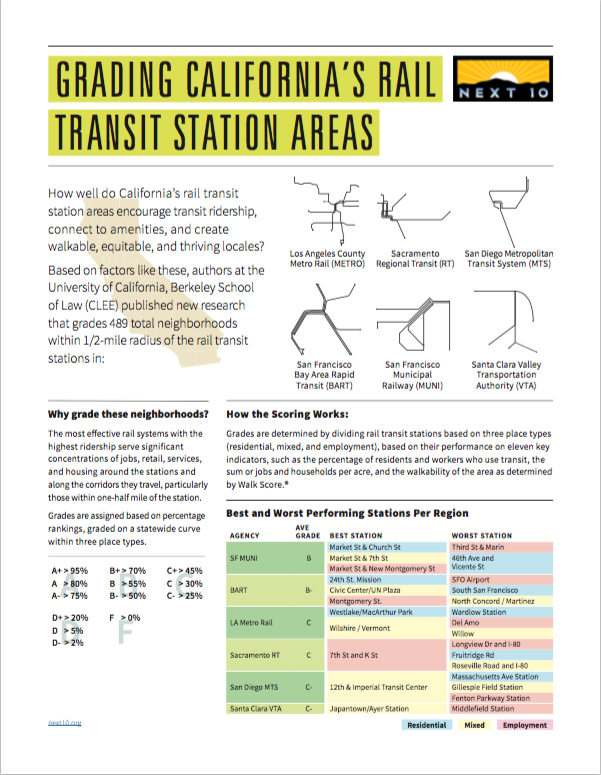Publications
Grading California's Rail Transit Station Areas
Scorecard grades California rail transit stations—which stations serve as hubs of thriving neighborhoods and which don't? A new analysis of California's rail transit systems discovers which transit stations serve as hubs of thriving, walkable areas that encourage residents and workers alike to ride the train, and which station areas need improvement.
The researchers analyzed 498 neighborhoods within a half-mile radius of stations in six California rail transit systems. Of the six transit systems evaluated, MUNI scored a B, the statewide highest average station area grade. MUNI was followed by BART, which earned a B-, Los Angeles Metro Rail and Sacramento Regional Transit (RT), both of which scored Cs and San Diego Metropolitan Transit (MTA) and Santa Clara VTA, both of which scored C-.
The report divided rail transit station areas into three types: residential, employment, and mixed, and calculated grades based on 11 key indicators including walkability, ridership levels, existing land-use and permitting policies, affordability and transit quality. Researchers also offered recommendations to improve station area performance, including prioritizing rail transit for neighborhoods that already contain a high concentrations of jobs and housing and financing development projects in under-performing regions.
Grading California's Rail Transit Station Areas, issued by Next 10 and prepared by the Center for Law, Energy and the Environment (CLEE) at the UC Berkeley School of Law, gives the highest grade statewide to the San Francisco Municipal Railway's (MUNI) Market Street and Church Street station, which performs the best overall when it comes to connecting riders to key amenities, cutting the environmental impact of transportation and contributing to a vibrant, pedestrian-friendly community. San Diego Metropolitan Transit System's Gillespie Field Station, by contrast, was assessed the lowest statewide score for lack of ridership and access to amenities and services.
Next 10 does not own the rights to this publication. Usage of this content is subject to permissions, please contact us at info@next10.org for more information.
Walk Score® data provided by Redfin Real Estate
Among the rail transit areas featured in the report:
- As mentioned, MUNI's Market Street and Church Street station scored a chart-topping A+ thanks to a near-perfect walkability score and a high rate of transit use and zero-vehicle households in a half-mile radius around the station.
- No MUNI station received a failing grade, though the Third Street and Marin Street station received a D, the system's lowest score, for lack of walkability and amenities.
- San Francisco's Powell Street BART station scored a high for walkability and levels of ridership while the South San Francisco BART station scored low primarily for low usage by residential riders and limited access to amenities.
- The Santa Clara VTA's Japantown/Ayer Station performed the best system wide, receiving a B+ from the researchers, while the Middlefield Station, located in a low-density area toward the edge of the system's service area scored low across all indicators.
- San Diego's 12th and Imperial station got the top score in the region while Gillespie Field Station, located in a car-dependent area, scored poorly across the board.
- The Los Angeles area's best-scoring Station is LA Metro's Westlake/MacArthur Park station, which scores high on diversity of destinations, walkability, transit access, and affordability, but gets a poor safety score because of crime. Wardlow Station in Long Beach had the lowest score in the transit system.
- While downtown Sacramento's 7th and K Street Station took the top score in the region, the Longview Drive and I-80 station is next to a major interstate, used for park-and-ride services, and is the region's lowest-scoring area with very low train use among local residents and workers.
- The San Joaquin Valley is California's fastest-growing region, but lacks rail transit. Researchers analyzed key busy bus station areas instead, awarding them separate grades ranging from B to D.
